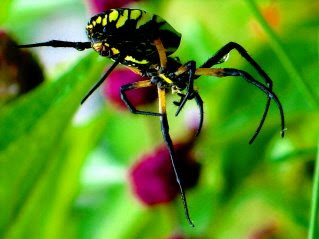
Suddenly and without warning, the colchicum have popped and begun spreading their autumn cheer through the garden. They act sort of like the "surprise lilies" (Lycoris) in that one day there is no sign of them, the next day there are buds poking through the soil and within 3-4 days of announcing their arrival they are in full bloom. It's a sure sign that autumn is on its way--shorter days, cooler temperatures and less humidity. Hallelujah!
There are a number of species and cultivars of colchicum, which go by the common names of autumn crocus (which they aren't) and also field or meadow saffron (which they also are not). Colchicum are colchicum--there are autumn flowering crocus (genus Crocus) and saffron (also genus Crocus) does happen to flower in the fall, too. I'd be careful of confusing colchicum with saffron, as the former is actually quite toxic. It's the bulb that is poisonous, but you certainly don't want to lace your loved ones' dinner with colchicum stamens (the herb saffron is the stamen of the saffron crocus, Crocus sativus) without knowing for certain that it won't inflict serious bodily harm.
Colchicums come in a variety of sizes and colors, mostly in the pink/lavender/white range and nearly all are somewhat larger than crocus in all respects--bigger flowers, bigger foliage, bigger bulbs. Of all of these, the species Colchicum autumnale is perhaps my favorite. It's not the largest of all of them, but it certainly is one of the most vigorous and robust. From a single bulb about 5 years ago, I now have at least a dozen large clumps scattered about the garden now. They multiply rapidly, so much so in fact that I noticed the other day that some of the bulbs have actually been pushed up out of the ground. Time to divide them again!
Early next summer, after the foliage has died completely down to the ground, I'll dig and separate the bulbs and replant them in small groups around the garden. When I divide, I usually plant 3 bulbs back into each generously sized hole and within 2-3 years they need dividing again.
Because of the overcrowding the show is spectacular this year, each clump sporting well over 50 blooms. The other great thing about colchicum is that not all of their buds open at once. The bulbs will continue to push buds up through the ground for about 2-3 weeks, the peak of bloom being the first week to 10 days and then slowly tapering off after that. After flowering is finished, a small rosette of foliage will appear and remain hunkered down close to the ground for the winter. Come spring, this rosette will grow and expand into a good sized clump of strappy green foliage and by mid- to late June they will have gone completely dormant waiting for just the right late summer day to poke their noses through the soil and regale us all with their beautiful blossoms again.
